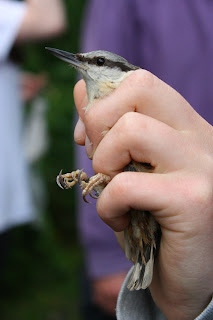An hour and a halves sleep later, I was up again for some bird ringing! As it happened this was interrupted with torrential rain and only a couple minutes into the ringing, we had to abandon it. Before the downpour, we did catch a Nuthatch, male Bullfinch, 1 Chiffchaff, 1 Robin and a single Chaffinch.
male Chaffinch
Nuthatch
It was as the rain began to bucket down that we remembered about the moth traps still being out, so in a mad rush we pelted around the reservoir attempting to salvage what might have been left inside them. Thankfully we didn't come across any drowned moths but we did bring the feeble results back to the toilet block at Argal where we kept them dry and IDed them before releasing them later in the day when the rain eased up. As it happens, despite IDing the lot, the rain water had fully saturated our heads and I could no longer soaked in any more of the names. In short, I can't remember the name of a single moth that we caught other than this decent IDable pic of a Grey Dagger which I photographed later in the day.
Grey Dagger
The evening mothing was by far the most productive and rounded the day of nicely from about 9pm-0:30ish the next morning. My species list for that evening comprised:
1. Common Marbled Carpet
2. Flame Shoulder
3. Green Carpet
4. Lychnis
5. Small-square Spot
6. Red Twin-spot Carpet
7. Square Spot
8. Common Wave
9. Buff-tip
10. Pale Tussock
11. Small Angle Shades
12. Brown Silver-line
13. Small Rivulet
14. Clouded Border
15. Peach Blossom
16. Pale Prominent
17. Square Spot
18. Devon Carpet
19. White Ermine
20. Peppered Moth
Buff-tip, almost everybodies highlight of the evening!
Small Rivulet
Flame Shoulder
Lychnis
forms 1/3: Common Marbled Carpet
forms 2/3: Common Marbled Carpet
forms 3/3: Common Marbled Carpet
Dark-barred Twin-spot Carpet
Pale Tussock
Small Angle Shades
Peach Blossom
Brown Silver-line
Common Wave
Clouded Border
Peppered Moth
Square Spot
Pale Prominent
Devon Carpet
Plenty of Cockchafers also inturupting the mothing session and just after midnight, I found this young Palmated Newt scuttling across the path.
Palmate Newt
Cockchafer
Caddisfly species




























This is no longer Samuel Birding but Samuel Mothing. Do you know how many species were recorded.
ReplyDelete